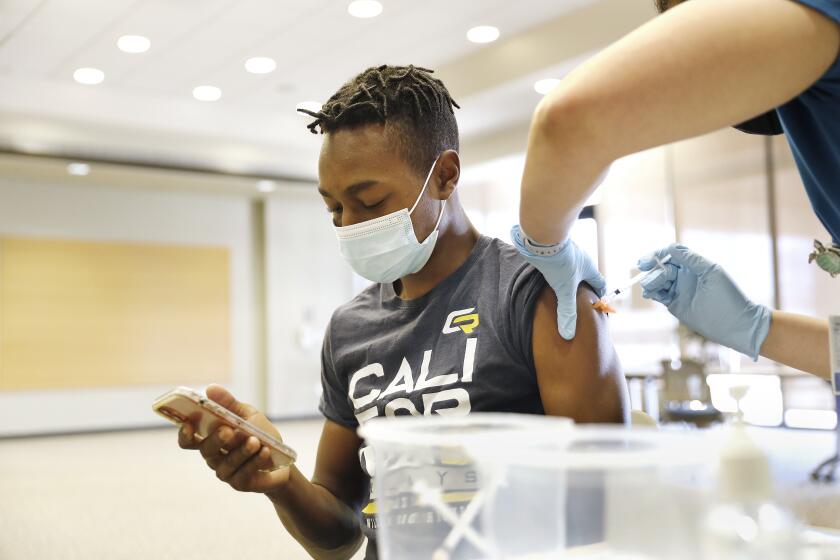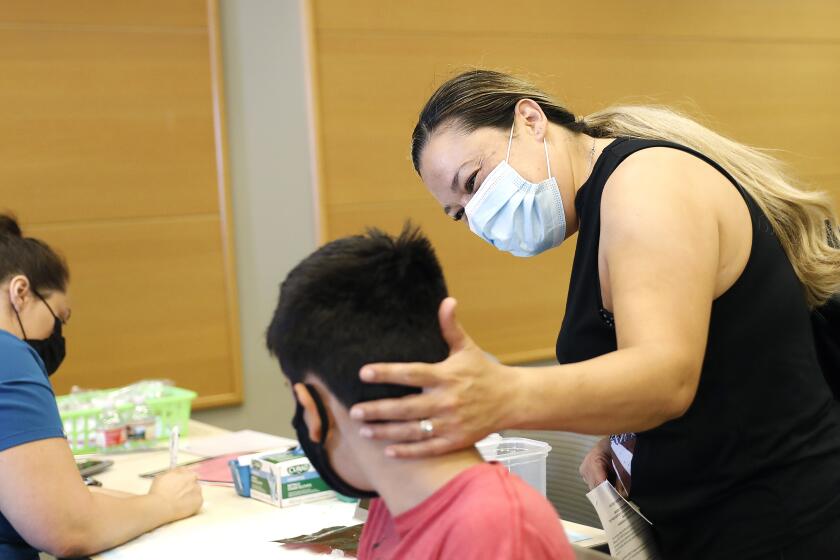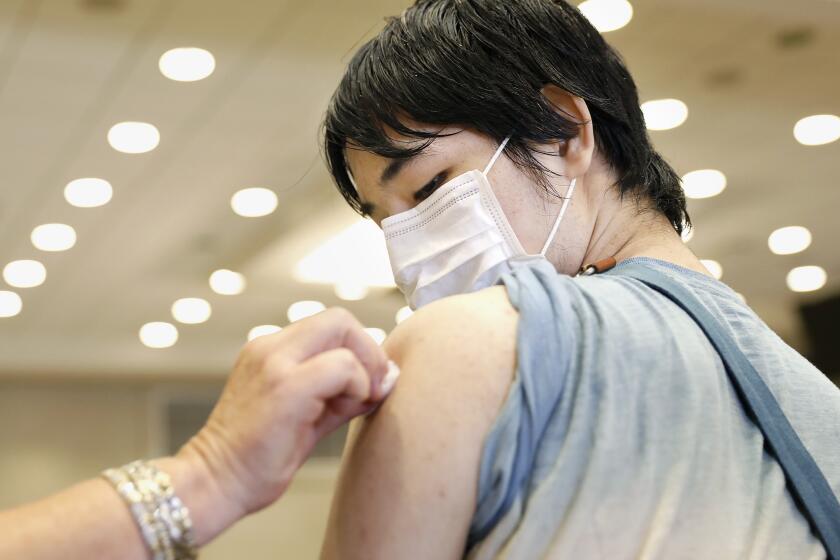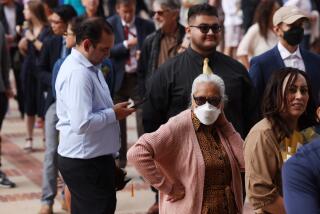COVID-19 cases surge in L.A. County, fueled by ‘enormously selfish’ unvaccinated
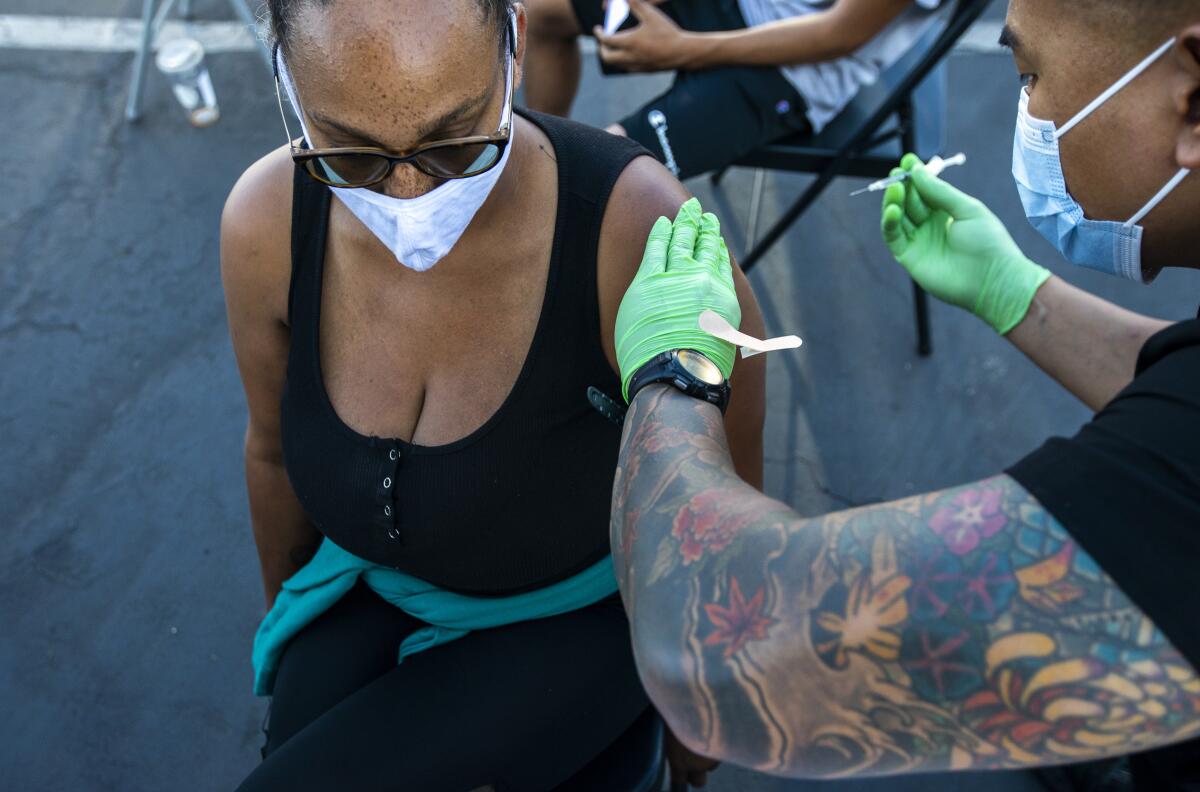
For the fifth consecutive day, Los Angeles County has recorded more than 1,000 new coronavirus cases.
Health officials say the upward trajectory is almost entirely driven by transmission among those who have yet to be vaccinated for COVID-19, as well as increased circulation of the easily spread Delta variant of the virus.
“It’s clear that the threat of COVID-19 is still with us and that we are dealing with a more infectious variant that causes it,” county Health Officer Dr. Muntu Davis said. “The best collective action that each of us can take is to get vaccinated against COVID-19 if you’re eligible, and to take sensible precautions if you are not eligible or choose not to get vaccinated.”
Over the weeklong period ending Monday, the county reported an average of 910 new cases per day — a nearly 250% increase from two weeks ago, according to data compiled by The Times.
The county Department of Public Health reported 1,044 coronavirus cases on Friday followed by 1,069 more on Saturday and an additional 1,113 Sunday, On Monday, there were 1,059 new cases.
Davis reported 1,103 new cases Tuesday.
The tally marks the fourth consecutive day that new cases totaled more than 1,000, health officials said.
L.A. County Supervisor Sheila Kuehl said she hopes those who are unvaccinated “understand the impact that they have, not only on their communities and their families but on other people in their communities” — including healthcare workers.
“It just strikes me as enormously selfish,” she said. “We can’t rely on herd immunity if the herd won’t get their shots.”
The increased spread is starting to have ripple effects in the county’s hospitals, which were caring for 398 coronavirus-positive patients as of Monday. That’s up 56% from two weeks ago.
COVID-19 deaths remain low, at about six per day countywide.
L.A. County officials have said that the overwhelming majority of new infections and hospitalizations are unvaccinated residents. Public Health Director Barbara Ferrer said Monday that “over 99% of the COVID-19 cases, hospitalizations and deaths we are seeing are among unvaccinated individuals.”
Although The Times’ data show nearly 52% of all Angelenos are fully vaccinated, that still leaves millions more who aren’t yet eligible, haven’t yet had a workable opportunity or have chosen to forgo the shots.
That fact isn’t lost on health and elected leaders — especially with the memory of the deadly fall-and-winter surge still fresh in the minds of many who were on the front lines.
“The healthcare workers will continue doing everything they can to support the lives and health of the individuals that come in, but it’s really been a very challenging year and, I think, made all the more challenging because we see the suffering that these patients and their families are going through, and it’s very preventable at this point in time,” Dr. Christina Ghaly, the county’s director of health services, told the Board of Supervisors on Tuesday.
Unvaccinated people, perhaps hoping they might outlast the pandemic without getting a shot or getting sick, may be playing an increasingly risky game of chance.
For Supervisor Janice Hahn, seeing the case count grow by 1,000 each day “is very unnerving, and it really gives you a feeling of déjà vu from March of 2020 in how they just kept doubling, tripling until, next thing you know, we had the Mercy ship here.”
But the big difference, she noted, is that the vaccines are now available.
“It’s so troubling that that ‘last third’ is just not going to get vaccinated,” she said.
Obtaining herd immunity — the level at which enough people are protected that the coronavirus is essentially starved of new hosts — has always been the eventual goal of the vaccine campaign. Estimates vary, but experts generally believe between 70% and 85% of the population would need to be vaccinated to achieve long-lasting protection.
Some public health experts have said effective approaches for persuading people to get vaccinated include answering questions and making the vaccine even more available to those who may not have prioritized getting the shot, either because they don’t think COVID-19 is a threat to them or they’ve heard misinformation.
Experts say only a small fraction of residents are adamantly opposed to vaccinations. Quite a few residents who haven’t been vaccinated simply need more information about why getting the shot is still important, they say.
“Relationships really matter,” Ghaly said. Giving people “an opportunity to ask their questions, to get fact-based information about the vaccine, to be given a chance to just talk through their concerns” is an effective approach, she added.
“One-on-one conversations — it’s very labor intensive, not always very fast, it takes time. But that’s been the best thing that has really helped,” Ghaly said.
Other efforts include mobile vaccination units, such as one that recently visited the eastern L.A. County suburb of Pomona. More than 300 people were vaccinated over the weekend at a swap meet.
Some of the people who got vaccinated there “just really had a different idea about what the vaccine was about,” Supervisor Hilda Solis said.
While the county’s metrics still remain relatively low, the rapid increases in case and positivity rates indicate that the coronavirus is spreading more widely.
Although there was initial optimism that L.A. County could potentially hit that threshold as soon as this month, the timeline has been stretched as the vaccination pace has slowed. Ferrer said last week that the best-case scenario would likely entail achieving herd immunity by early fall.
Until that happens, officials warn that the unvaccinated remain vulnerable to infection and illness — especially given the presence of the Delta variant, which is believed to be twice as transmissible as the conventional coronavirus strains.
According to figures Davis presented Tuesday, out of 4.67 million fully vaccinated people in L.A. County, .06% later tested positive, .004% had to be hospitalized for COVID-19 and .0004% eventually died.
Despite that, L.A. County still recommends that everyone — even those who are fully vaccinated — wear masks in public indoor spaces as a precaution.
Davis also said residents, especially those who have yet to be inoculated, should reconsider traveling to states with high case rates, such as Nevada, Missouri, Florida, Arkansas and Louisiana.
“With transmission on the rise, the best protection from COVID-19 is to be fully vaccinated, even after you’ve been infected,” he said.
Times staff writer Rong-Gong Lin II contributed to this report.
More to Read
Sign up for Essential California
The most important California stories and recommendations in your inbox every morning.
You may occasionally receive promotional content from the Los Angeles Times.
